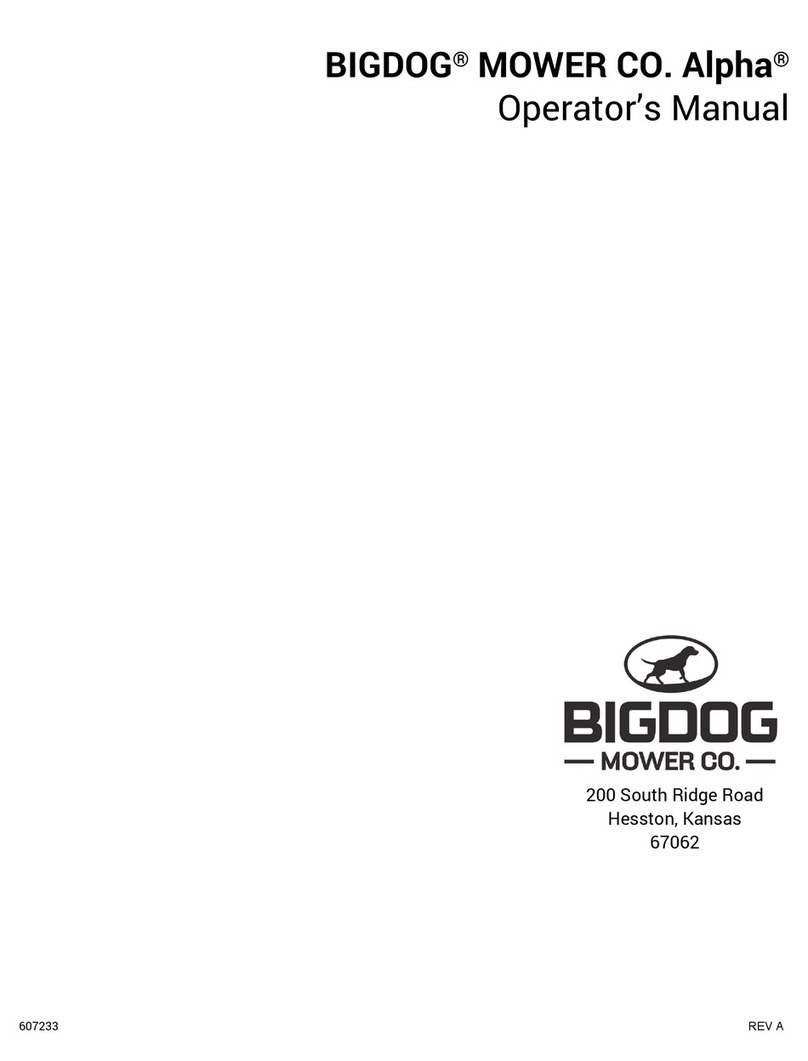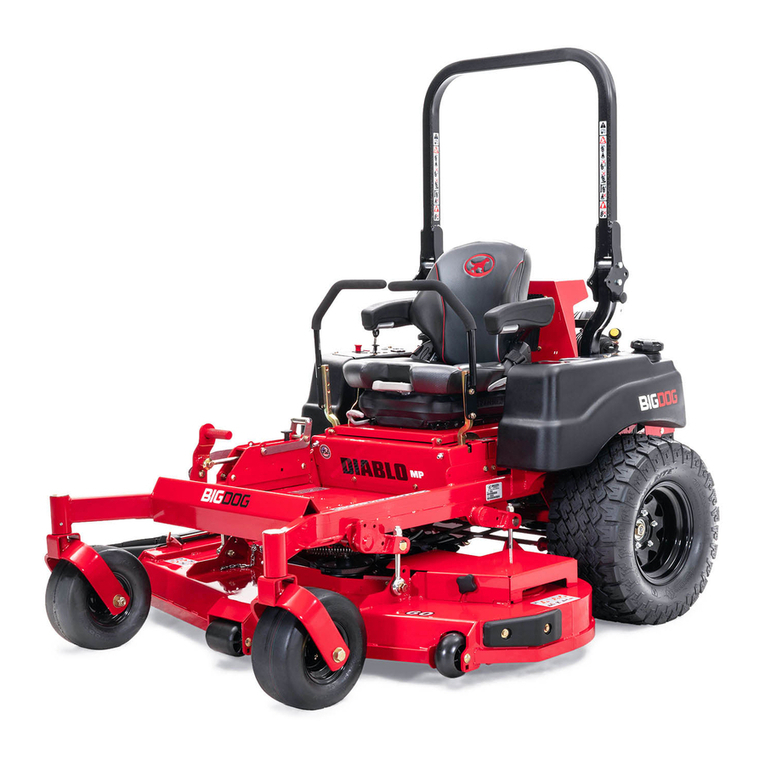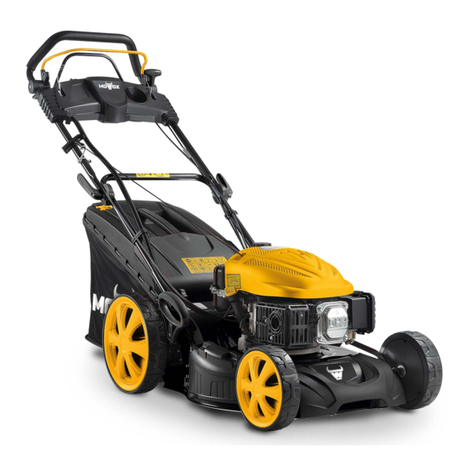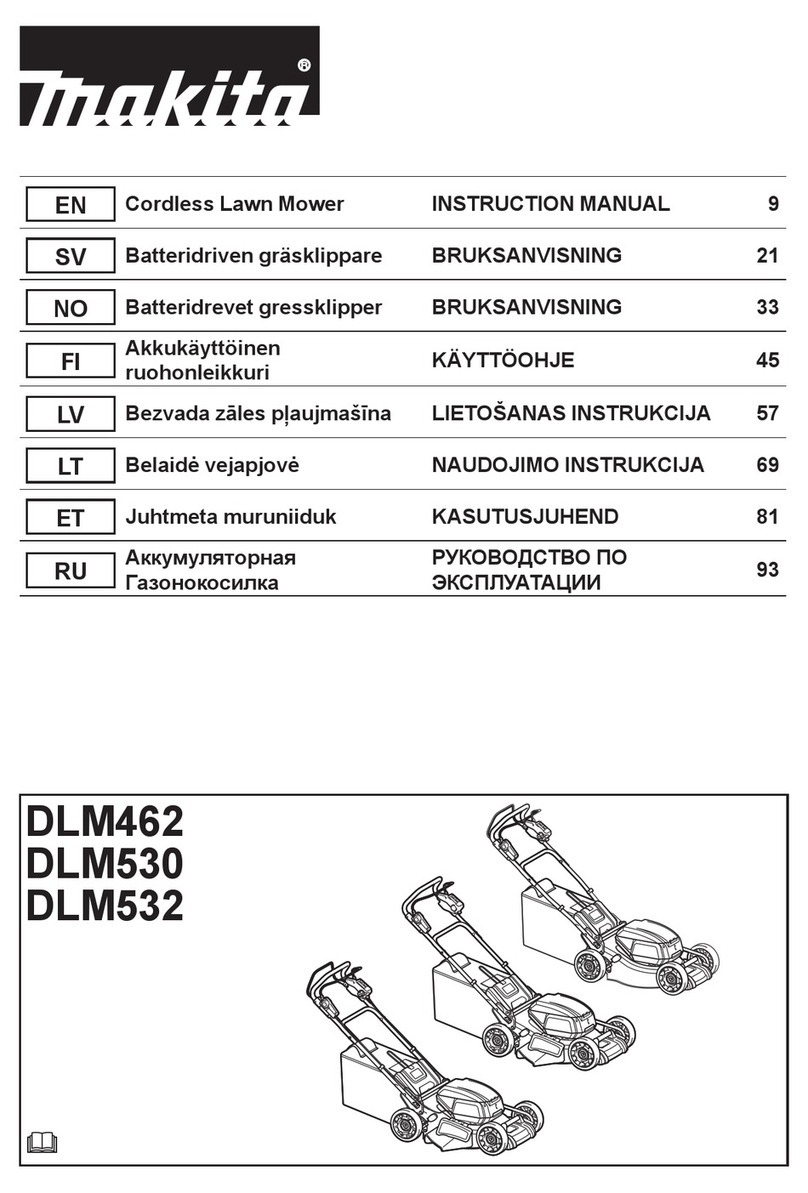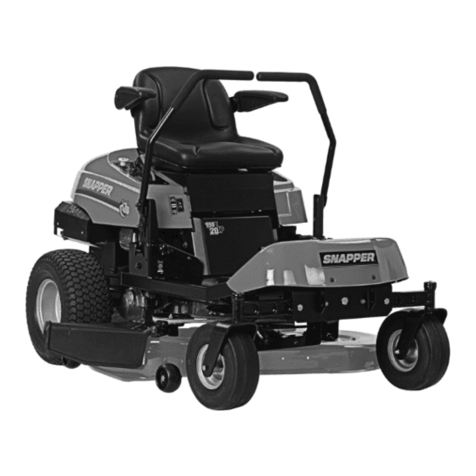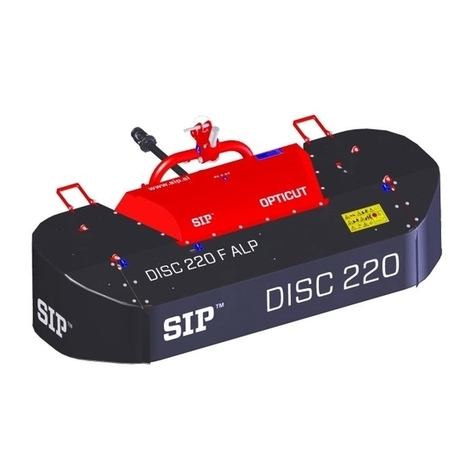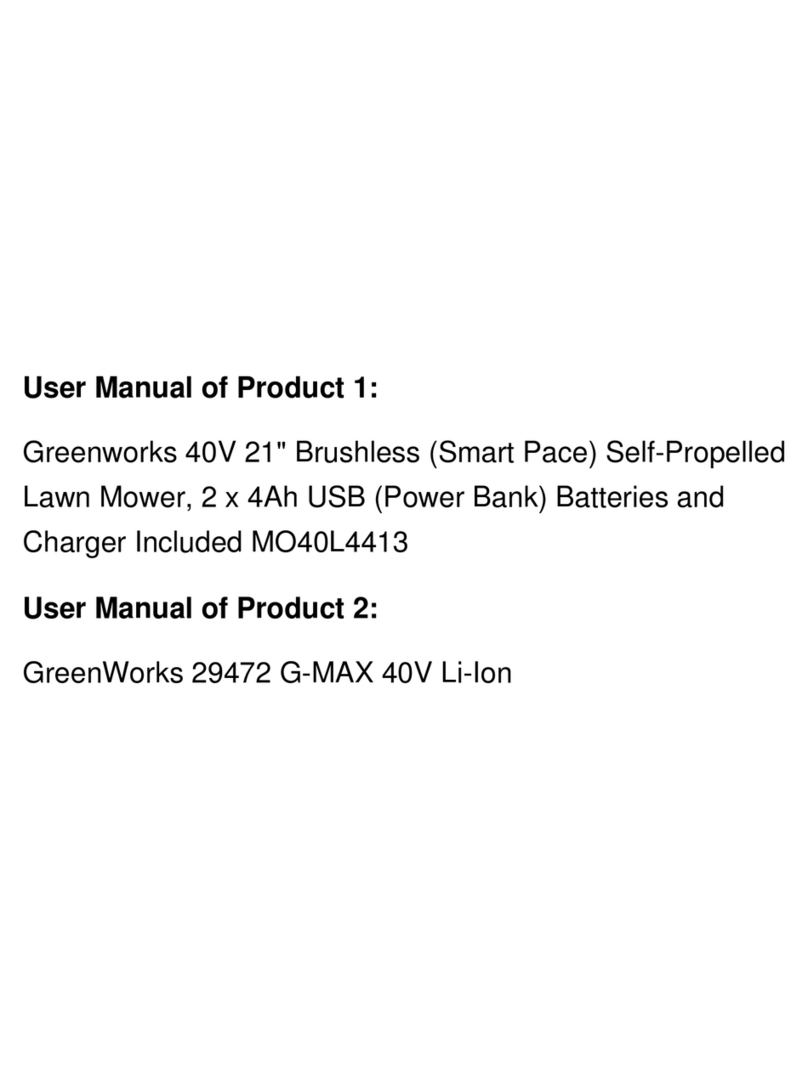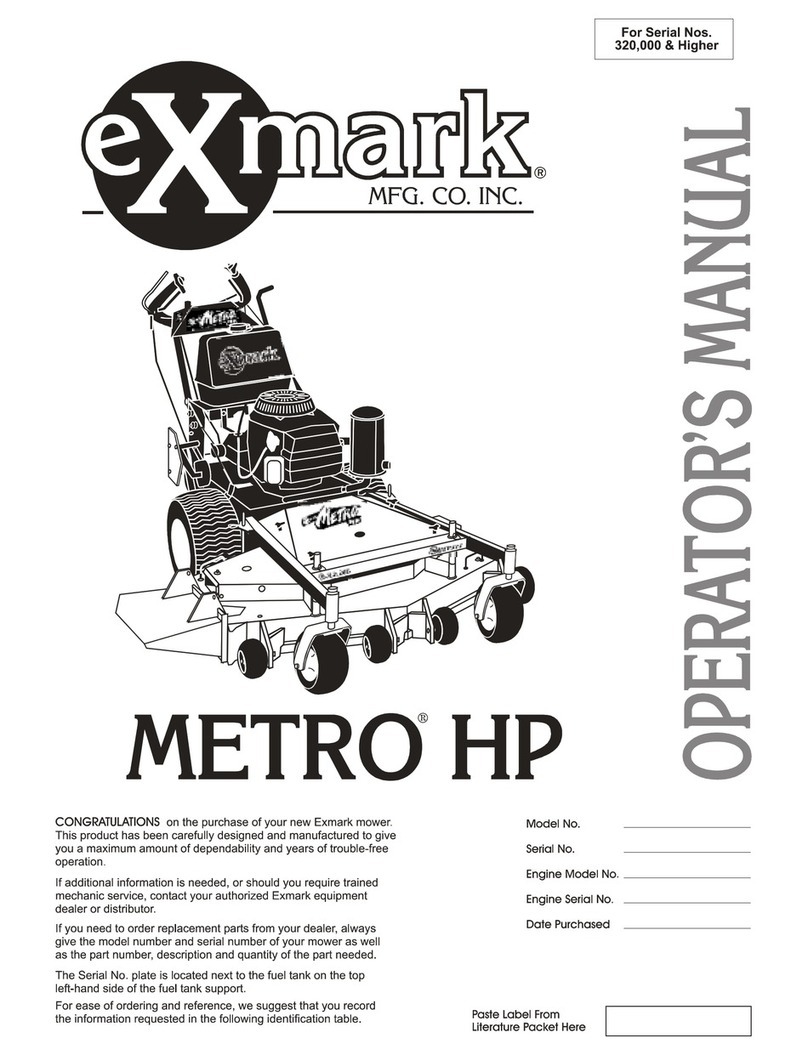BigDog Mower ALPHA MPX User manual

125277 REV A
BIGDOG®MOWER CO. ALPHA®MPX
General Service Manual
200 South Ridge Road
Hesston, Kansas
67062

The Engine Owner’s Manual provides information regarding the U.S. Environmental Protection Agency
(EPA) and the California Emission Control Regulation of emission systems, maintenance and warranty.
Keep Engine Owner’s Manual with your unit. Should the Engine Owner’s Manual become damaged or
illegible, replace immediately. Replacements may be ordered per the information found in the Product
Information section of the owner’s manual.
Federal law and California State law prohibit the following acts or the causing thereof:
1. The removal or rendering inoperative by any person other than for purposes of maintenance,
repair, replacement, of any device or element of design incorporated into any equipment for
the purposes of emissions control prior to or after its sales or delivery to the ultimate
purchaser or while it is in use, or
2. The use of the equipment after such device or element of design has been removed or
rendered inoperative by any person.
NOTICE OF REQUIREMENT OF SPARK ARRESTER MUFFLER
This equipment may create sparks that can start fires around dry vegetation. California Public Resources Code
Section 4442.6 provides that it is unlawful to use or operate an internal combustion engine on any forest-covered,
brush-covered, or grass-covered land unless the engine is equipped with a spark arrester maintained in effective
working order. A spark arrester is a device constructed of nonflammable materials specifically for the purpose of
removing and retaining carbon and other flammable particles over 0.0232 of an inch in size from the exhaust flow of
an internal combustion engine that uses hydrocarbon fuels or which is qualified and rated by the United States
Forest Service. Other states or federal areas may have similar laws. The Operator Should Contact Local Fire
Agencies For Laws or Regulations Relating to Fire Prevention Requirements. THIS EQUIPMENT DOES NOT HAVE
A SPARK ARRESTER AND YOU SHOULD CONTACT YOUR AUTHORIZED DEALER FOR THE PURCHASE OF
A SPARK ARRESTER.
Inspect spark arrester daily; replace every 500 hours or as needed.
WARNING
The engine exhaust from this product
contains chemicals known to the state
of California to cause cancer, birth
defects or other reproductive harm.
REV A 125277

125277 REV A
Table of Contents
General Information . . . . . . . . . . . . . . . . . . . . . . . . . . . . . . . . . . . . . . . . . . . . . 1-1
BigDog®Service Program. . . . . . . . . . . . . . . . . . . . . . . . . . . . . . . . . . . . . 1-1
Maintenance Introduction. . . . . . . . . . . . . . . . . . . . . . . . . . . . . . . . . . . . . 1-1
Warranty . . . . . . . . . . . . . . . . . . . . . . . . . . . . . . . . . . . . . . . . . . . . . . . . . . . 1-1
Safety. . . . . . . . . . . . . . . . . . . . . . . . . . . . . . . . . . . . . . . . . . . . . . . . . . . . . . . . . 2-1
Safe Servicing Practices . . . . . . . . . . . . . . . . . . . . . . . . . . . . . . . . . . . . . . 2-1
Pre-Operation Precautions . . . . . . . . . . . . . . . . . . . . . . . . . . . . . . . . . . . . 2-1
Operation Precautions. . . . . . . . . . . . . . . . . . . . . . . . . . . . . . . . . . . . . . . . 2-2
Operate Machine Safely . . . . . . . . . . . . . . . . . . . . . . . . . . . . . . . . . . . . . . 2-2
General Maintenance Precautions. . . . . . . . . . . . . . . . . . . . . . . . . . . . . . 2-2
Maintenance Precautions. . . . . . . . . . . . . . . . . . . . . . . . . . . . . . . . . . . . . 2-3
Torque . . . . . . . . . . . . . . . . . . . . . . . . . . . . . . . . . . . . . . . . . . . . . . . . . . . . . . . . 3-1
Standard Torques. . . . . . . . . . . . . . . . . . . . . . . . . . . . . . . . . . . . . . . . . . . . 3-1
Special Torques . . . . . . . . . . . . . . . . . . . . . . . . . . . . . . . . . . . . . . . . . . . . . 3-1
Power Unit Maintenance . . . . . . . . . . . . . . . . . . . . . . . . . . . . . . . . . . . . . . . . . 4-1
Steering Adjustments . . . . . . . . . . . . . . . . . . . . . . . . . . . . . . . . . . . . . . . . 4-1
Park Brake Spring Adjustment . . . . . . . . . . . . . . . . . . . . . . . . . . . . . . . . . 4-4
Transaxle Drive Belt. . . . . . . . . . . . . . . . . . . . . . . . . . . . . . . . . . . . . . . . . . 4-5
Hydraulic system . . . . . . . . . . . . . . . . . . . . . . . . . . . . . . . . . . . . . . . . . . . . 4-7
Tires. . . . . . . . . . . . . . . . . . . . . . . . . . . . . . . . . . . . . . . . . . . . . . . . . . . . . . 4-10
Engine Maintenance. . . . . . . . . . . . . . . . . . . . . . . . . . . . . . . . . . . . . . . . . . . . . 5-1
General Engine Maintenance . . . . . . . . . . . . . . . . . . . . . . . . . . . . . . . . . . 5-1
Engine Oil and Filter . . . . . . . . . . . . . . . . . . . . . . . . . . . . . . . . . . . . . . . . . 5-1
Engine Air Filter . . . . . . . . . . . . . . . . . . . . . . . . . . . . . . . . . . . . . . . . . . . . . 5-1
Fuel Evaporation System Filter. . . . . . . . . . . . . . . . . . . . . . . . . . . . . . . . . 5-2
Fuel and Evaporative System Line Routing . . . . . . . . . . . . . . . . . . . . . . 5-2
Deck Adjustments . . . . . . . . . . . . . . . . . . . . . . . . . . . . . . . . . . . . . . . . . . . . . . 6-1
Deck Leveling . . . . . . . . . . . . . . . . . . . . . . . . . . . . . . . . . . . . . . . . . . . . . . . 6-1
Blades . . . . . . . . . . . . . . . . . . . . . . . . . . . . . . . . . . . . . . . . . . . . . . . . . . . . . 6-1
Deck Belt . . . . . . . . . . . . . . . . . . . . . . . . . . . . . . . . . . . . . . . . . . . . . . . . . . . 6-4

REV A 125277
Electrical . . . . . . . . . . . . . . . . . . . . . . . . . . . . . . . . . . . . . . . . . . . . . . . . . . . . . . 7-1
Maintenance . . . . . . . . . . . . . . . . . . . . . . . . . . . . . . . . . . . . . . . . . . . . . . . . . . . 8-1
Troubleshooting . . . . . . . . . . . . . . . . . . . . . . . . . . . . . . . . . . . . . . . . . . . . . . . . 9-1

125277 1-1 REV A
GENERAL INFORMATION
BigDog®Service Program
This manual is part of a service package for the BigDog®
Alpha®MPX mowers. Use of this manual in conjunction with
other BigDog®mower and component manuals will provide
the information necessary to service and maintain the
BigDog®Alpha®MPX mower.
This General Service Manual is a service guide for use by
Service Technicians. It provides the necessary information
needed to perform normal maintenance requirements on
these units.
The Parts Manual provides a complete parts listing for the
unit. Use this manual when ordering parts.
The Operator's Manual provides fundamental operational
information and operational safety that is needed when
operating the mower.
The component manuals are furnished by the various
manufacturers to be used for the troubleshooting and
servicing of their components.
Maintenance Introduction
Regular maintenance is the best prevention for downtime
or premature failure. The following pages contain suggested
maintenance information and schedules which the operator/
mechanic should follow on a routine basis.
Remain alert for unusual noises, they could be signaling a
problem. Visually inspect the machine for any abnormal wear
or damage. A good time to detect potential problems is while
performing scheduled maintenance service. Correcting the
problem as quickly as possible is the best insurance.
Clear away heavy build-up of grease, oil and dirt, especially
in the engine compartment and under the seat platform
areas; minute dust particles are abrasive to close-tolerance
engine and hydraulic assemblies.
Daily inspect mower for grass clippings and wire and string
tangles. The underside of the mower deck will collect a build-
up of grass clippings and dirt, especially when grass is wet or
has high moisture content. This build-up will harden,
restricting blade and air movement and will probably show a
lesser quality of cut. Therefore it should be removed
routinely.
To do this it will be necessary to raise and block the deck,
using jack stands or blocks, in the full up position and scrape
the build-up from underneath.
Some repairs require the assistance of a trained service
mechanic and should not be attempted by unskilled
personnel. Consult your BigDog®Mowers service center
when assistance is needed.
Information included in this manual was current at the time
of printing, but subsequent production changes may cause
your machine to vary slightly in detail. BigDog®Mowers
reserves the right to redesign and change the machine as
deemed necessary, without notification. If a change has been
made to your machine which is not reflected in this service
manual contact the Customer Service Department at
BigDog®Mowers for additional information.
Warranty
Warranty repair must be performed by a BigDog®Mowers
Authorized Dealer before warranty credit can be allowed.

REV A 1-2 125277

125277 2-1 REV A
SAFETY
This safety alert symbol is used to call attention to a
message intended to provide a reasonable degree of
PERSONAL SAFETY for operators and other persons during
the normal operation and servicing of this equipment.
Safe Servicing Practices
Refer to the Safety Precautions section of this manual for
more service safety information.
Understand Correct Service
Be sure you understand a service procedure before
you work on the machine.
Unauthorized modifications to the machine may
impair the function and/or safety and affect machine
life.
If it is necessary to make checks with the engine
running, always use two people - with the operator at
the controls, able to see the person doing the
checking.
Pre-Operation Precautions
Fuel Handling
To avoid personal injury or property damage, use
extreme care in handling fuel. Fuel is extremely
flammable and the vapors are explosive.
Observe usual fuel handling precautions:
•Do not smoke while refueling. Extinguish all
cigarettes, cigars, pipes and other sources of
ignition.
• Do not remove fuel cap or fill tank with engine
running or while engine is hot. Clean up any fuel
spills.
•Allow engine to cool before storing machine
inside a building.
•Keep fuel away from open flame or spark and
store machine away from open flame or spark or
pilot light such as on a water heater or
appliances.
•Use extreme care when handling gasoline and
other fuels. They are extremely flammable and
vapors are explosive. A fire or explosion from fuel
can burn you and others and can damage
property.
•Refuel outdoors. Never refuel or drain the fuel
from the machine indoors.
•Never attempt to start engine when there is a
strong odor of gasoline or diesel fuel fumes
present. Locate and correct cause.
•Store fuel in an approved container and keep it
out of the reach of children. Never buy more than
a 30 day supply of fuel.
•Do not fill fuel containers inside a vehicle or on a
truck or trailer bed with interior carpets or plastic
truck bed liners. Always place fuel containers on
the ground away from your vehicle before filling.
•When practical, remove gas or diesel fuel
powered equipment from the truck or trailer and
refuel the equipment with its wheels on the
ground. If this is not possible, then refuel such
equipment on the truck or trailer using a portable
container and not a fuel dispenser nozzle. If a
fuel dispenser nozzle must be used, keep the
nozzle in contact with the rim of the fuel tank or
container opening at all times until fueling is
complete. Do not use a nozzle lock-open device.
•Never use gasoline or diesel fuel for cleaning
parts.
•Read and observe safety precautions elsewhere
in this manual.
Gasoline and diesel fuel is harmful or fatal if
swallowed.
•Long-term exposure to vapors can cause serious
injury and illness.
•Avoid prolonged breathing of vapors.
•Keep face away from nozzle and gas tank or fuel
container opening.
•Keep fuel away from eyes and skin.
•If fuel is spilled on clothing, change clothing
immediately.
– denotes immediate hazards which WILL result in
severe personal injury or death.
– denotes a hazard or unsafe practice which
COULD result in severe personal injury or death.
DANGER
WARNING

REV A 2-2 125277
Understand Machine Operation
Only qualified and trained personnel should operate
the equipment.
Carefully read the operator’s manual and all manuals
furnished with the attachments. Learn the location
and purpose of all controls, instruments, indicators
and labels.
Wear Protective Clothing
Do not operate or service the equipment while wearing
sandals, tennis shoes, sneakers, shorts or any type of
loose fitting clothing. Long hair, loose clothing or
jewelry may get tangled in moving parts. Always wear
long pants, safety glasses, ear protection and safety
shoes when operating or servicing this machine.
Always wear adequate eye protection when servicing
the hydraulic system and battery, or when grinding
mower blades and removing accumulated debris.
Prolonged exposure to loud noise can cause
impairment or loss of hearing.
•Always wear adequate ear protection, such as
earplugs, when operating this equipment as
prolonged exposure to uncomfortable or loud
noises can cause impairment or loss of hearing.
•Do not wear radios or music headphones while
operating the machinery. Safe operation requires
your full attention.
Operation Precautions
Avoid Fire Hazards
Clean flammable material from machine. Prevent fires by
keeping engine compartment, top of deck, exhaust area,
battery, hydraulic lines, fuel line, fuel tank and operator’s
station clean of accumulated trash, grass clippings, and
other debris. Always clean up spilled fuel and oil.
Start Engine Safely
Avoid possible injury or death from machine runaway.
Do not start engine by shorting across starter
terminals.
Before you start the engine:
•Sit on the operator’s seat.
•Move control levers to the neutral/brake position.
Operate Machine Safely
Refer to the unit’s operator’s manual for complete
safety information on safe machine operation.
Always maintain a safe distance from people and pets
when mowing
Always be aware of what is behind the machine before
backing up.
Never leave machine unattended with ignition key in
switch, especially with children present.
Follow daily and weekly checklists, making sure hoses
are tightly secured and bolts are tightened.
Always keep engine and machine clean, removing
accumulated dirt, trash and other material from
machine.
Never put hands or feet under any part of the machine
while it is running.
Never attempt to start engine when there is a strong
odor of gasoline fumes present. Locate and correct
cause.
Keep all safety shields and covers in place, except for
servicing.
Do not touch hot parts of machine.
General Maintenance Precautions
Repairs or maintenance requiring engine power should
be performed by trained maintenance personnel only.
Never run the engine in an enclosed area unless
exhaust is vented to the outside. Exhaust gases
contain carbon monoxide which is an odorless and
deadly poison.
Unless specifically required, DO NOT have the engine
running when servicing or making adjustments to the
mower.
•Park the mower on level ground
•Disengage the deck clutch.
•Place the steering control levers in the park brake
position.
•Lower the deck.
•Stop the engine.
•Remove the ignition key.
•Disconnect the negative battery cable.
•Wait for all movement to stop before adjusting,
cleaning or repairing.
•Repairs or maintenance requiring engine power
should be performed by trained maintenance
personnel only.
•To prevent carbon monoxide poisoning, operate
the engine in a well ventilated area only.
•Read and observe all safety warnings in this
manual.
Before working on or under the deck, make certain
engine cannot be accidentally started. Shut engine off,
remove ignition switch key and disconnect negative
battery cable for maximum safety.
Except when changing or checking belt, always keep
belt covers on mower deck for safety as well as
cleanliness.

125277 2-3 REV A
Use a stick or similar instrument to clean under the
mower making sure that no part of the body, especially
arms and hands are under mower.
Keep your machine clean and remove any deposits of
trash and clippings, which can cause engine fires and
hydraulic overheating as well as excessive belt wear.
Clean up oil or fuel spillage.
Allow the mower, especially the engine, to cool in a well
ventilated area before storing inside a building or other
enclosure.
Always wear adequate eye protection when servicing
the hydraulic system and battery, or when grinding
mower blades and removing accumulated debris.
Never attempt to make any adjustments or repairs to
the mower drive system, mower deck or any
attachment while the engine is running or deck clutch
is engaged.
Exercise caution when releasing spring tension from
any of the belt idlers or when working with any of the
deck lift components.
Never work under the machine or attachment unless it
is safely supported with jack stands. Make certain
machine is secure when it is raised and placed on the
jack stands. The jack stands should not allow the
machine to move when the engine is running and the
drive wheels are rotating. Use only certified jack stands.
Use only appropriate jack stands, with a minimum
weight rating of 2000 pounds to block the unit up. Use
in pairs only. Follow the instructions supplied with the
vehicle stands.
Keep nuts and bolts tight, especially the blade
attachment bolts. Keep equipment in good working
condition.
Never tamper with safety devices. Check their proper
operation regularly.
Exercise caution when working under the deck as the
mower blades are extremely sharp. Wrap the blade(s)
or wear gloves and use extra caution when servicing
them.
Use original BigDog®Mower replacement parts or
parts that are equivalent in overall performance.
•The mower may not comply with the appropriate
safety standards if aftermarket parts,
accessories, or attachments are used.
Maintenance Precautions
Avoid Fire Hazards
Be prepared if an accident or fire should occur. Know
where the first aid kit and the fire extinguishers are
located and how to use them.
Provide adequate ventilation when charging batteries.
Do not smoke near battery.
Never check fuel level with an open flame.
Never use an open flame to look for leaks anywhere on
the equipment.
Never use an open flame as light anywhere on or
around the equipment.
When preparing engine for storage, remember that fuel
stabilizer is volatile and therefore dangerous. Seal and
tape openings after adding the inhibitor. Keep
container tightly closed when not in use.
Inspect electrical wiring for worn or frayed insulation.
Install new wiring if wires are damaged.
Prepare for Emergencies
Be prepared if a fire starts.
Keep a first aid kit and fire extinguishers available.
Keep emergency numbers for doctor, ambulance
service, hospital, and fire department near the
telephone.
Prevent Battery Explosions
Battery posts, terminals, and related accessories
contain lead and lead compounds, chemicals known to
the State of California to cause cancer and
reproductive harm. Wash hands after handling.
Charge batteries in an open well-ventilated area, away
from sparks and flames. Unplug charger before
connecting or disconnecting from battery. Wear
protective clothing and use insulated tools.
Avoid skin and clothing contact with battery acid.
•Always wear eye protection when checking the
battery, acid can cause serious injury to skin and
eyes. If contact occurs, flush area with clean
water and call physician immediately. Acid will
also damage clothing.
•Do not drink the battery electrolyte.
•Do not allow open flame near the battery when
charging.
•Hydrogen gas forms inside the battery. This gas
is both toxic and flammable and may cause an
explosion if exposed to flame. Always disconnect
the negative (black) battery cable(s) before
disconnecting the positive (red) cable(s). Always
connect the positive (red) battery cable(s) before
connecting the negative (black) cable(s).
•Do not overfill battery.
•Electrolyte may overflow and damage paint,
wiring or structure. When cleaning the battery,
use soap and water. Be careful not to get soap
and water into the battery. Clean the battery
terminals with a solution of four parts water and
one part baking soda when they become
corroded.

REV A 2-4 125277
Shorts caused by battery terminals or metal tools
touching metal mower components can cause sparks.
Sparks can cause a battery gas explosion which will
result in personal injury.
•Prevent the battery terminals from touching any
metal mower parts when removing or installing
the battery.
•Do not allow metal tools to short between the
battery terminals and metal mower parts.
Incorrect battery cable routing could cause damage to
the mower and battery cables. This can cause sparks
which can cause a battery gas explosion which will
result in personal injury. Always disconnect the
negative (black) battery cable(s) before disconnecting
the positive (red) cable(s). Always connect the positive
(red) battery cable(s) before connecting the negative
(black) cable(s).
Avoid Acid Burns
Sulfuric acid in battery electrolyte is poisonous. It is
strong enough to burn skin, eat holes in clothing and
cause blindness if splashed in eyes.
Avoid the hazard by:
•Filling batteries in a well-ventilated area.
•Wearing eye protection and rubber gloves.
•Avoiding breathing fumes when electrolyte is
added.
•Avoiding spilling or dripped electrolyte.
If you spill acid on yourself:
•Flush your skin with water.
•Apply baking soda or lime to help neutralize the
acid.
•Flush your eyes with water for 10-15 minutes. Get
medical attention immediately.
If acid is swallowed:
•Drink large amounts of water or milk.
•Then drink milk of magnesia, beaten eggs or
vegetable oil.
•Get medical attention immediately.

125277 3-1 REV A
TORQUE
Standard Torques
The following chart lists the standard torque values for the threaded fasteners found in this manual. Torque all cap screws, nuts
and set screws to these values unless a different torque is shown in the Special Torques section.
Special Torques
NOTE:
1. Lug nuts only – It is recommended that these be
checked after the first 2 hours of operation and every
40 hours and following removal for repair or
replacement.
2. Engine torque values – Refer to the respective engine
owner’s manual.
3. If clutch mounting bolt is loosened or removed, do not
re-use. Replace with a new bolt. Use only hand tools to
install this fastener.
Size ft-lbs N•m Size ft-lbs N•m
#10 32.4 IN.-LBS. 3.6 M3 12 IN.-LBS. 1.3
.250 98.4 IN.-LBS. 11.1 M4 26.4 IN.-LBS. 3
.312 204 IN.-LBS. 23 M5 54 IN.-LBS. 6.1
.375 30 40 M6 92.4 IN.-LBS. 10.4
.438 48 65 M8 222 IN.-LBS. 25
.500 73 99 M10 37 50
.562 105 143 M12 64 87
.625 145 200 M14 103 140
.750 260 350 M16 160 215
.875 420 565 M20 320 435
Description ft-lbs N-m
Wheel (lug) nuts 170 95
Blade spindle bolt top 73 99
Blade spindle bolt bottom 118 160
Electric clutch mounting bolt 347 63.7
Front wheel axle bolt Tighten the nut, then back it off
until the wheel spins freely.
Transaxle hub nut 200 271
Transaxle pump pulley nut 50 67.8
Engine torques 2N/A N/A
Particular attention must be given to tightening the
drive wheel lug nuts and blade spindle bolts. Failure
to correctly torque these items may result in the loss
of a wheel or blade, which can cause serious
damage or personal injury.
WARNING

REV A 3-2 125277

125277 4-1 REV A
POWER UNIT MAINTENANCE
Steering Adjustments
Steering control lever neutral adjustment
The mower’s steering has been factory adjusted to
eliminate creeping when the steering control levers are in the
neutral position. However, should the mower begin to creep,
the steering control lever linkage can be adjusted.
Before considering any adjustment, check the tire air
pressure. Unequal tire pressure will cause the mower to drift
to one side. Refer to tire pressure information in the Tire
section for detailed information.
NOTE: Proper park brake adjustment must be completed
before the steering control lever neutral adjustment can be
done. Refer to the Park Brake Spring Adjustment section for
detailed information.
Fine adjustment to the unit’s steering is made with the
transmission’s control rod.
Neutral is properly adjusted when the steering control
levers are in the park brake position and the transmissions
do not “whine”.
If this occurs, the steering control linkage may be adjusted
as follows:
1. Shut engine off, place steering control levers in the
park brake position, disengage deck clutch, remove
ignition switch key and disconnect negative battery
cable before doing any adjustments.
2. Raise the rear of the mower and block with certified
jack stands. Remove the rear wheels.
3. Chock the front tires.
4. Make sure both steering control levers are in the park
brake position. Figure 4-1
Never work under the machine or attachment unless
it is safely supported with jack stands.
•Make certain machine is secure when it is
raised and placed on the jack stands.
• Use only certified jack stands. Use only
appropriate jack stands, with a minimum
weight rating of 2000 pounds (907 kg) to
block the unit up.
•Use in pairs only.
•Follow the instructions supplied with the
jack stands.
•The jack stands should not allow the
machine to move when the engine is running
and the drive wheels are rotating.
•Do not allow the wheels to come in contact
with the floor or any object that would permit
the unit to propel itself.
•To prevent injury stay clear and exercise
caution when rotating the wheels.
WARNING
Keep hands, hair, clothing, etc., clear of the pulleys
on top of the transmissions. Exercise extreme
caution.
Untrained maintenance personnel should never
attempt to make any adjustments or repairs to the
mower’s drive system while the engine is running.
The following procedures should be performed by
trained maintenance personnel only.
Steering control levers in park brake position
A. Steering control lever
Figure 4-1
WARNINGWARNING
A

REV A 4-2 125277
5. Loosen the nuts adjacent to the steering bushing.
Figure 4-2
6. Place a clamp on the transmission pump arm as
shown in Figure 4-3.
7. Tighten the nuts against steering bushing. Verify that
the pump arms are still in the neutral position.
Figure 4-2
8. Move the steering control levers out of the park brake
position and push fully forward. Verify that the pump
arm does not bottom out against the stop on the
transmission. Move the levers to the full reverse
position and release. Verify that the levers return near
to the neutral position.
9. The steering control levers should be adjusted so that
they align vertically with each other (± .125") when in
the neutral position (Figure 4-4). The space between
the ends of the steering control handles should be
.50" ±.25". Figure 4-4
10. Check to make sure all tools or obstructions are
removed from under the mower.
11. Re-install the rear wheels. Torque lug nuts to 70 ft-lbs
(95 N•m).
12. Raise the rear of the mower and remove the jack
stands. Lower the mower.
13. Re-attach the negative battery cable.
14. Close the seat platform.
Steering Damper
The steering damper is spring loaded to return the steering
control levers to the neutral position from the reverse
position. This gives the operator a sense of neutral during
operation.
If the mower does not return to neutral from reverse then
adjust as follows:
To set the steering dampers in the correct operating
position follow these steps:
1. Shut engine off, place steering control levers in the
park brake position, disengage deck clutch, remove
ignition switch key and disconnect negative battery
cable before doing any adjustments.
2. Place the steering control levers in the neutral
position. Figure 4-5
3. Loosen the steering damper’s rear ball stud. Figure 4-6
4. Pull the damper spring housing, to the rear, past the
point that the internal spring is engaged.
5. Release the damper spring housing and allow the
internal spring to bring the housing back to the neutral
position.
6. Tighten the nut on the steering damper’s rear ball stud.
7. Reconnect the negative battery cable.
A. Bushing B. Nuts
Figure 4-2
A. Clamp
Figure 4-3
B
A
B
A
A. Align handles ± .125"
Figure 4-4
A

125277 4-3 REV A
8. To check, move the steering control lever to the
reverse position and release. The steering control lever
should return to the neutral position. If not, repeat
steps 1 through 7.
Control lever stops adjustment
The steering control lever stops may be adjusted to help
drive straight when the steering control levers are pushed
forward against the stops.
1. Raise the rear of the mower and block with certified
jack stands.
2. Chock the front tires.
3. Make sure both steering control levers are in the park
brake position. Figure 4-7
4. Raise the seat platform and disconnect the mower
harness from the seat switch. Bypass the seat switch
by connecting the two mower harness female spades
together. Figure 4-8
5. Start the engine and move both steering control levers
forward against the stops in the steering cover.
6. Determine if the drive wheels are rotating equally or if
one is faster than the other. If the wheels are not the
same speed, proceed to the next step.
A. Steering control levers
Figure 4-5
A. Rear ball stud B. Damper spring housing
Figure 4-6
A
A
A
B
Keep hands, hair, clothing, etc., clear of the rotating
drive wheels/hubs during this process. Exercise
extreme caution.
Steering control levers in park brake position
A. Steering control lever
Figure 4-7
Do not operate (drive) the mower without plugging
the mower’s wiring harness into the seat switch.
This switch is an important part of the safety start
interlock system. Serious injury can result if the seat
switch is not plugged into the mower’s wiring
harness.
WARNING
A
WARNING

REV A 4-4 125277
7. Shut engine off and place the steering control levers in
the park brake position.
8. Loosen the cap screw under the seat platform on the
side which is rotating too fast. Tighten the cap screw
on the top of the steering cover to adjust the drive
straight bracket up to stop the steering control lever
sooner. Repeat this procedure until both drive wheels
rotate at the same speed. Figure 4-9
9. Tighten the cap screws under the seat platform on
both sides to lock the drive straight brackets in place.
Snug the cap screws on the top of the steering cover
so they don't move during operation.
IMPORTANT: With the engine off, disconnect the two
female spade connectors from each other (from step
#4) and reconnect them to the seat switch. This must
be completed so that the safety circuit is functioning
properly. Figure 4-8
10. Lower the seat platform and secure in place.
Park Brake Spring Adjustment
Occasionally check the park brake spring adjustment using
the following method:
1. Shut engine off, place steering control levers in the
park brake position, disengage deck clutch, remove
ignition switch key and disconnect negative battery
cable before doing any adjustments.
2. Make sure steering control levers are in the park brake
position.
3. Adjust the nylock nut on the end of the brake rod so
that 0.25" of thread is showing. Repeat for other side.
Figure 4-10
4. Reconnect the negative battery cable.
A. Female spades
B. Seat switch C. Mower harness
Figure 4-8
Do not operate the mower without plugging the
mower’s wiring harness into the seat switch. This
switch is an important part of the safety start
interlock system. Serious injury can result if the seat
switch is not plugged into the mower’s wiring
harness.
B
C
AA
WARNING
Never operate the mower with a non-functioning
seat switch. Always reconnect the seat switch to the
mower harness.
A. Cap screws B. Drive straight bracket
Figure 4-9
WARNING
A
B

125277 4-5 REV A
5. Close seat platform and re-install seat platform
hardware.
Transaxle Drive Belt
Inspect belts frequently for wear and serviceability.
Replace a belt that shows signs of:
•severe cuts
•tears
•separation
•weather checking
•cracking
•burns caused by slipping.
Slight raveling of belt covering does not indicate failure,
trim ravelings with a sharp knife.
Inspect the belt pulley grooves and flanges for wear. A new
belt, or one in good condition, should never run against the
bottom of the groove. Replace the pulley when this is the
case, otherwise, the belt will lose power and slip excessively.
Never pry a belt to get it on a pulley as this will cut or
damage the fibers of the belt covering.
Keep oil and grease away from belts, and never use belt
dressings. Any of these will destroy the belt composition in a
very short time.
Transaxle Drive Belt Adjustment
The transaxle drive belt tension remains constant by
means of a tension idler and spring. There is no tension
adjustment of this belt. Figure 4-11
NOTE: Inspect the belt every month and replace as
needed. Replace the belt every two (2) years.
Transaxle Drive Belt Replacement
1. Park the mower on a flat surface and stop the engine.
•Make sure deck clutch switch is in the down
(OFF) position.
•Place the steering control levers in the park brake
position.
•Remove ignition key. Make sure the blades are
stopped before leaving seat.
•Disconnect the negative battery cable.
A. Nut B. Adjust to .25"
Figure 4-10
A
B
If the transaxle belt fails, loss of control will occur
especially when operating on a slope. If you lose
steering control while operating the machine, place
the steering control levers in the park brake position
immediately. Inspect the machine and involve your
dealer to resolve the problem.
A. Transaxle drive belt
B. Spring C. Tension idler
Figure 4-11
This procedure will require that the mower to be
raised and blocked up off of the ground.
•Use only appropriate vehicle stands, with a
minimum weight rating of 2000 pounds to
block the unit up.
•Use in pairs only.
•Follow the instructions supplied with the
vehicle stands.
WARNING
A
B
C
WARNING

REV A 4-6 125277
2. Lower the deck to the lowest setting.
3. Unhook the tension idler spring from the spring mount
to release tension from the deck drive belt.
Figure 4-12
4. Raise the rear of the mower and block with certified
jack stands.
5. Remove the deck drive belt from the electric clutch
pulley located on the engine shaft. Figure 4-13
NOTE: Do not remove the deck drive belt from the deck
spindle pulleys. It will only need to be removed from the
electric clutch pulley at the rear of the mower.
6. Locate the tension idler spring. Securely clamp locking
pliers onto the spring at the end located next to the
idler arm. Figure 4-13
7. Release the transaxle drive belt tension, using the
locking pliers, to remove the tension spring from the
idler arm. Swing the idler arm out of the way.
Figure 4-13
8. Remove the transaxle drive belt from the transaxle
drive pulleys and the engine pulley. Figure 4-13, &
Figure 4-14
9. Replace the transaxle drive belt and route it around the
engine pulley and the transaxle drive pulleys.
Figure 4-14
10. Make sure the transaxle drive belt is routed correctly
around the tension idler before attaching the tension
spring. Using the locking pliers, re-attach the tension
spring to the idler arm to re-tension the transaxle drive
belt. Remove the locking pliers from the tension
spring. Figure 4-14
11. Reroute the deck drive belt around the electric clutch
pulley. Make certain the belt is routed properly around
the spindle pulleys and stationary idler pulley(s).
Figure 4-13
12. Make certain the deck drive belt is in the pulleys and
routed correctly, then re-tension the deck drive belt by
pulling on the deck belt idler spring and hooking it in
the spring mount on the deck. Figure 4-15
13. Raise the rear of the mower and remove the jack
stands.
14. Lower the mower.
15. Re-attach the negative battery cable.
Allow the engine and muffler to cool before
proceeding with the following procedure.
Exercise caution when releasing spring tension from
the belt idler.
48"/54"/60" Decks
A. Deck covers
B. Spring mount C. Idler spring
Figure 4-12
WARNINGWARNING
A
AB
C
Top view with engine removed
A. Transaxle drive belt
B. Spring
C. Transaxle drive pulley
D. Idler arm
E. Deck drive belt
F. Electric clutch pulley
Figure 4-13
F
B
A
C
D
E

125277 4-7 REV A
Hydraulic system
This mower is equipped with two integrated hydrostatic
transmissions. Figure 4-17
IMPORTANT: Never use hydraulic or automatic
transmission fluid in this system; use only motor oil as
specified.
Use SAE 20W50 motor oil, 15W50 synthetic oil or 20W50
synthetic oil when changing the system oil and filter.
The hydraulic expansion tank is located in front of the
engine and under the operator’s platform. Figure 4-16
Check oil level in hydraulic system after every 40 hours of
operation or weekly, whichever occurs first. Check more
often if system appears to be leaking or otherwise
malfunctioning.
When the hydraulic system oil is cold, the fluid level should
be at the “Full Cold” line on the expansion tank. Use only the
specified oil shown.
Initial system oil and filter change must be after the first 75
hours of use or 1 year whichever comes first. Thereafter,
replace filter and oil in each transmission every 2 years or 200
hours, whichever comes first.
NOTE: The filter guard must be removed to access filter.
Each transmission’s filter is located per Figure 4-17. A
standard oil filter wrench is used to change filter, threads are
right handed.
Use a BigDog®Mowers approved filter element only.
IMPORTANT: Dirt is the primary enemy of any hydraulic
system.
IMPORTANT: When washing the mower, direct the spray
away (especially if using a power washer) from the
transmission’s seals to prevent water intrusion and to ensure
component performance.
Top view with engine removed
A. Transaxle drive pulley
B. Transaxle drive belt C. Engine pulley
D. Tension idler
Figure 4-14
48"/54"/60" mowers
A. Spring mount B. Idler spring
Figure 4-15
B
C
D
A
A
A
BA. Expansion tank
Figure 4-16
A

REV A 4-8 125277
Fluid changing procedure
1. Park the unit on a level surface.
•Place the steering control levers in the park brake
position.
•Disengage the deck clutch.
•Remove the ignition switch key.
•Disconnect the negative battery cable.
2. Remove the three 1/4” filter guard screws and filter
guard. Clean any loose debris from around the filter.
Figure 4-18
3. Place an oil drain pan beneath the oil filter and remove
the oil filter from the transaxle.
4. After the oil has been drained, wipe the filter base
surface off and apply a film of new oil to the gasket of
the new replacement filter.
5. Install the new filter by hand, turn 3/4 to one full turn
after the filter gasket contacts the filter base surface.
6. Re-install the filter guard with three 1/4” screws.
Torque the screws to 65 in-lbs each. Figure 4-18
7. Repeat steps 2–6 for the opposite side transaxle.
8. Drain oil filters of all free flowing oil prior to disposal.
Place used oil in appropriate containers.
9. IMPORTANT: Remove the top port plug from both
transaxles prior to filling with oil. This will allow the
transaxles to vent during oil fill. Figure 4-19
10. Remove the cap from the transaxle's expansion tank.
11. Fill with SAE 20W50 motor oil, 15W50 synthetic oil or
20W50 synthetic oil until oil just appears at the bottom
of each transaxles top port (approximately 2 qts. per
transaxle). Install the top port plug into each transaxle.
Torque plugs to 180 in-lbs. Clean up any oil that leaked
from the ports. Figure 4-19
12. Continue to fill the transaxles through the expansion
tank until the “Full Cold” line is reached on the
expansion tank.
13. Re-install the expansion tank cap by hand. Be careful
not to overtighten.
14. Proceed to the purge procedure.
A. Transmission B. Filter
Figure 4-17
A. Screw
B. Filter C. Filter guard
Figure 4-18
AB
BC
A
A
A. Top port plug
Figure 4-19
A
Table of contents
Other BigDog Mower Lawn Mower manuals
Popular Lawn Mower manuals by other brands
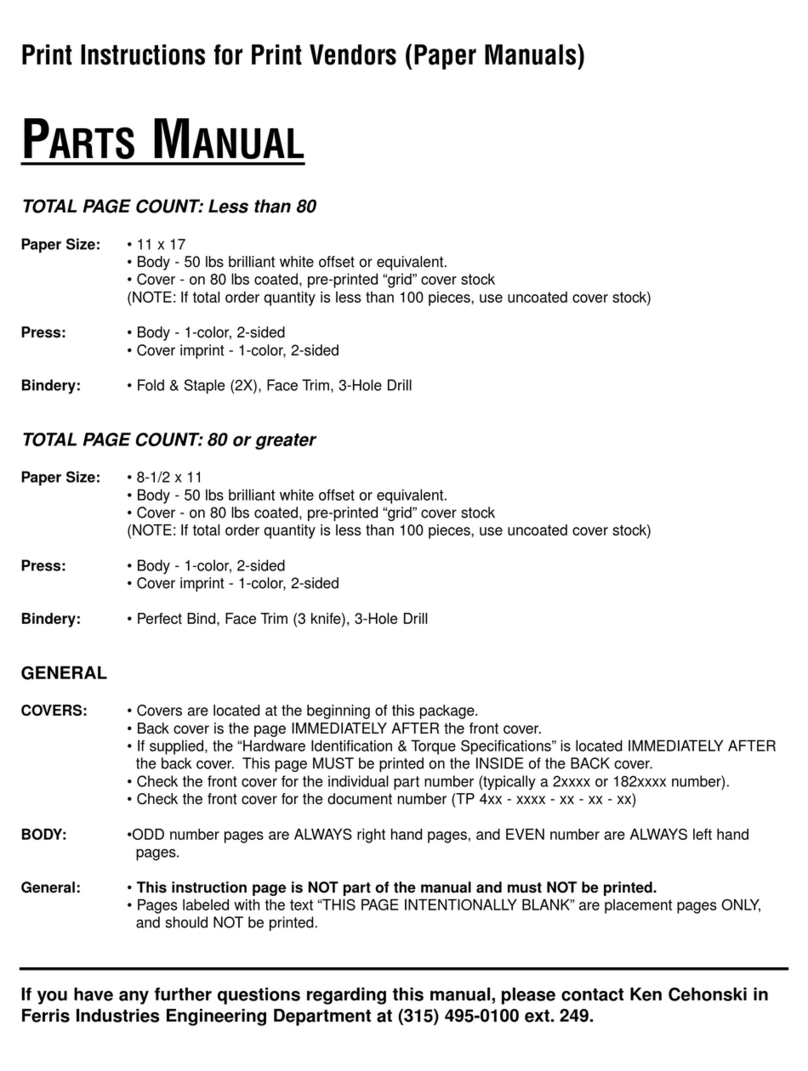
Simplicity
Simplicity Colt ZT2148 parts manual
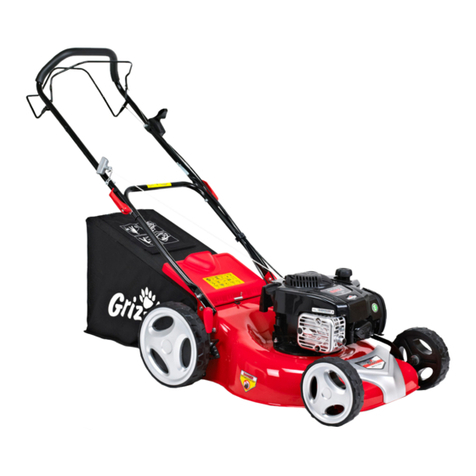
Grizzly
Grizzly BRM 51-2 BSA Translation of the original instructions for use
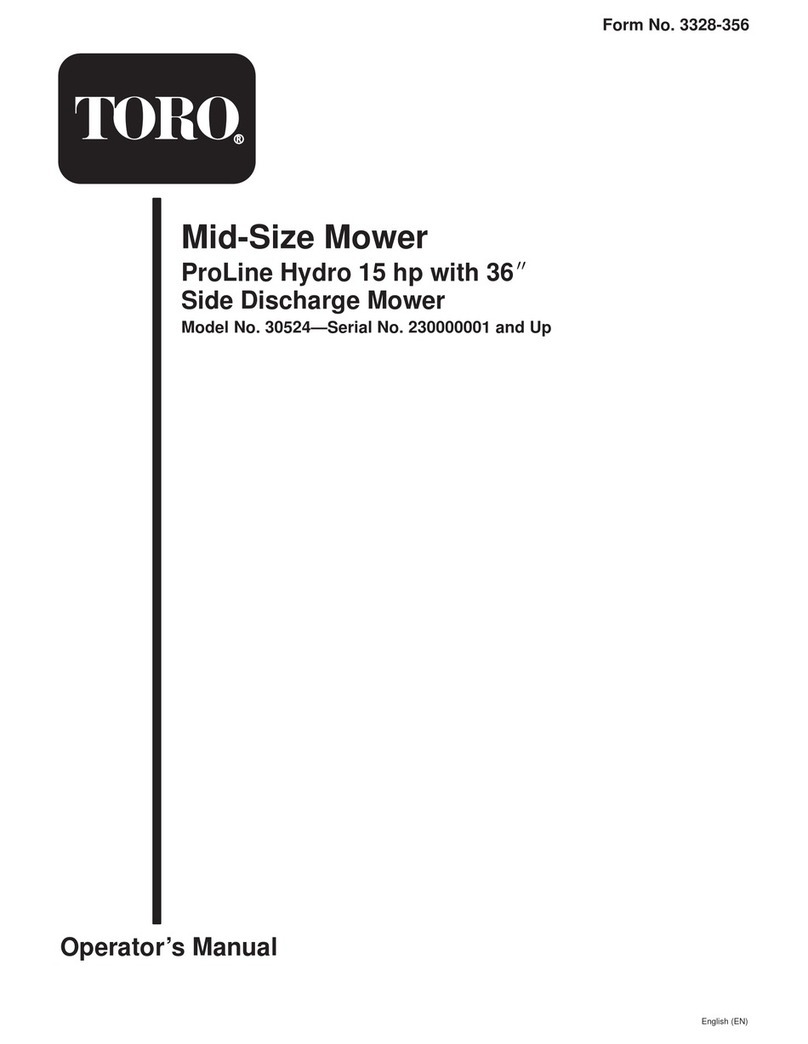
Toro
Toro 30524 Operator's manual

Castelgarden
Castelgarden SD98-108 owner's manual
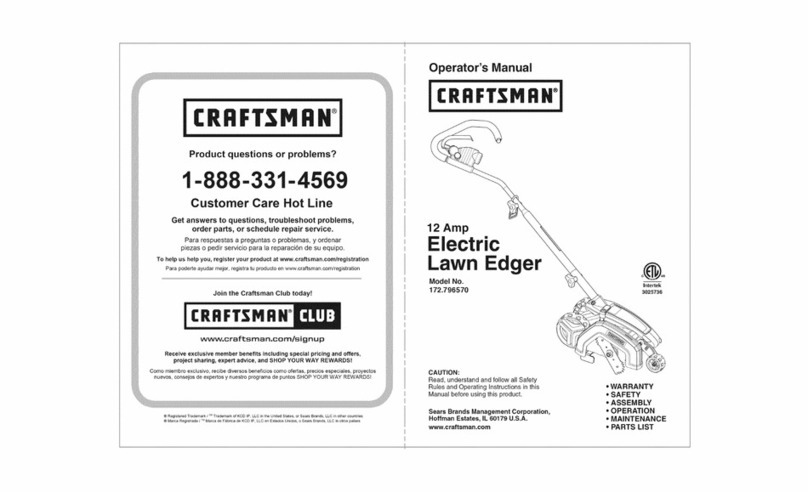
Craftsman
Craftsman 172.796570 Operator's manual
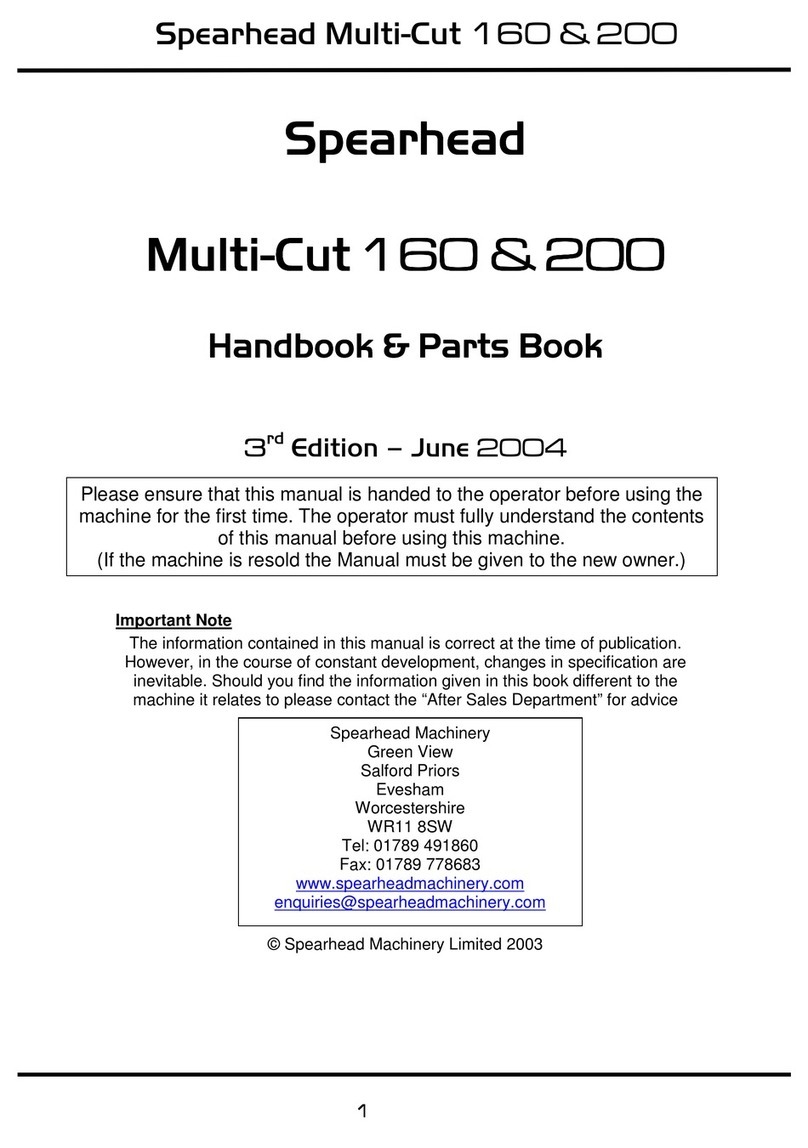
GreenTec
GreenTec Spearhead Multi-Cut 160 Handbook & Parts Book
